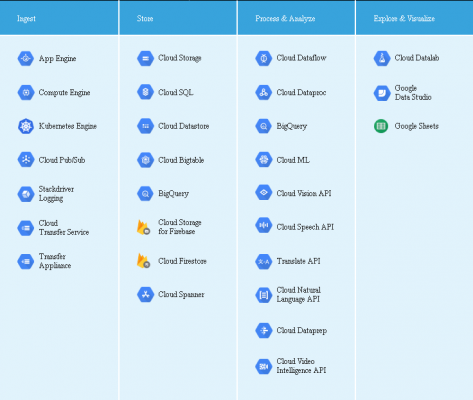Data Lifecycle Google Professional Data Engineer GCP
In this, we will learn about the data lifecycle.
- GCP has many services to manage data lifecycle – acquisition to final visualization.
- The data lifecycle steps.
- Ingest: Pull in the raw data, like streaming data from devices, on-premises batch data, app logs, or mobile-app user events and analytics.
- Store: Store data in a durable and easy access format.
- Process and analyze: Transformed data from raw into actionable information.
- Explore and visualize: Convert results of analysis into a format to draw insights.
GCP services for data life cycle-

Ingest
You may acquire raw data in a variety of ways, depending on the amount, source, and latency of the data.
- Data from app events, such as log files or user events, usually gathers via a push paradigm, in which the app uses an API to deliver the data to storage.
- Streaming: The data is a series of short, asynchronous messages that are in a continuous stream.
- Batch: A series of files containing a large amount of data is sent to storage in bulk.
Store
Data arrives in a variety of shapes and sizes, and its structure determines by the sources from which it derives. And, also the downstream use cases. Ingest data can store in a number of forms or places for data and analytics applications.
Process and analyze
You must convert and analyze data in order to gain business value and insights from it. This necessitates a processing architecture that can either analyze the data directly or prepare it for downstream analysis, as well as tools to assess and comprehend the outcomes of the processing.
- Processing: Data from source systems is cleansed, normalized, and processed across multiple machines, and stored in analytical systems.
- Analysis: Processed data stores in systems that allow for ad-hoc querying and exploration.
- Understanding: Depending on analytical results, data can be train and test automated machine-learning models.
Explore and visualize
In-depth data exploration and visualization are the final steps in the data lifecycle, and they help you better comprehend the outcomes of your processing and analysis. Insights operate improvements in the pace or amount of data input, the use of various storage mediums to expedite analysis, and upgrades to processing pipelines during exploration. Data scientists and business analysts having skills in probability, statistics, and recognizing business value, frequently explore and analyze big data sets.
